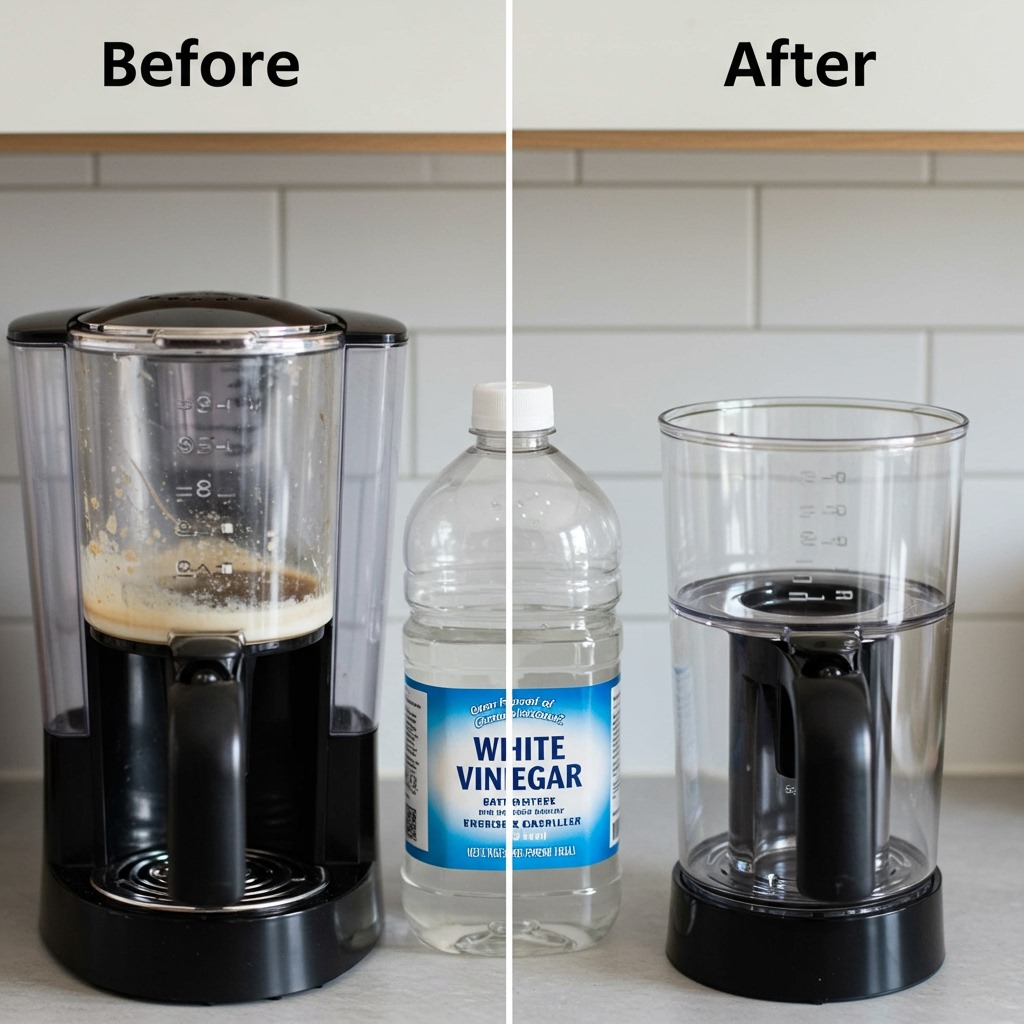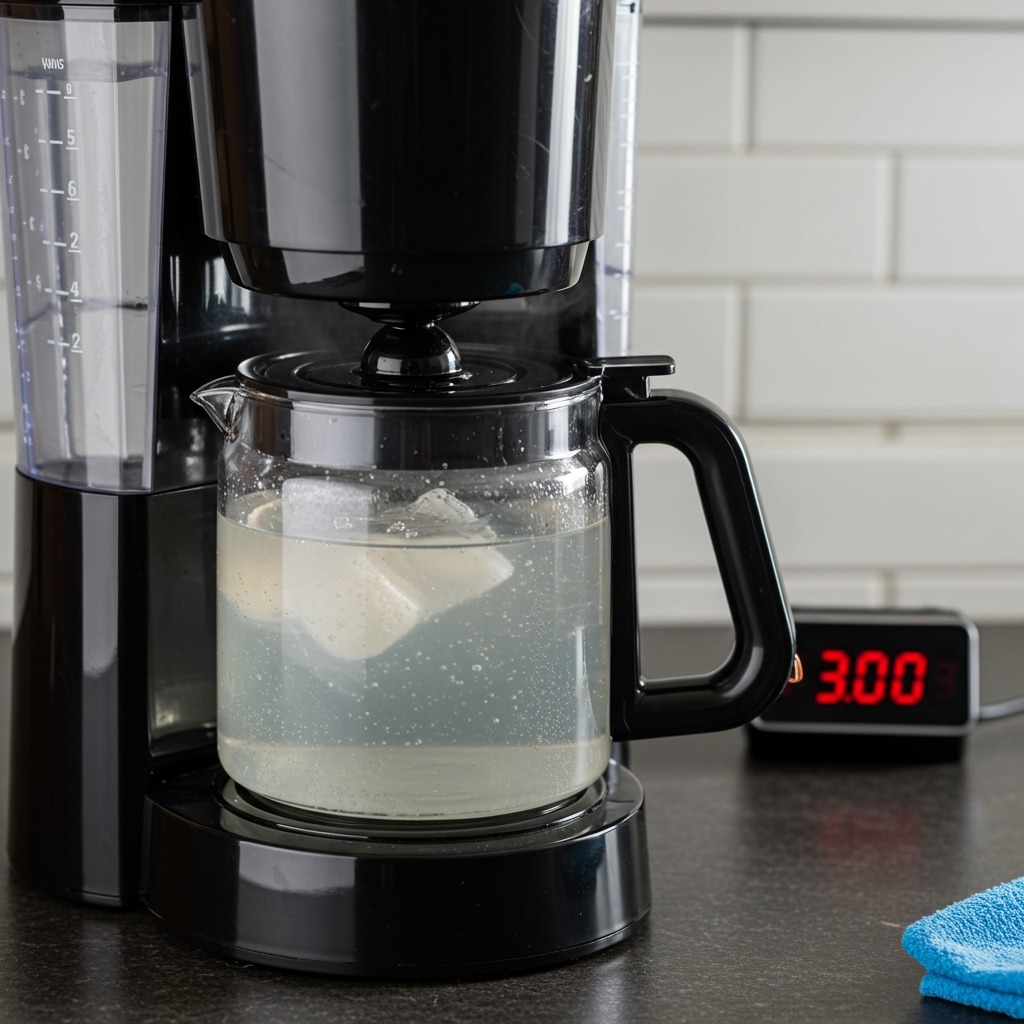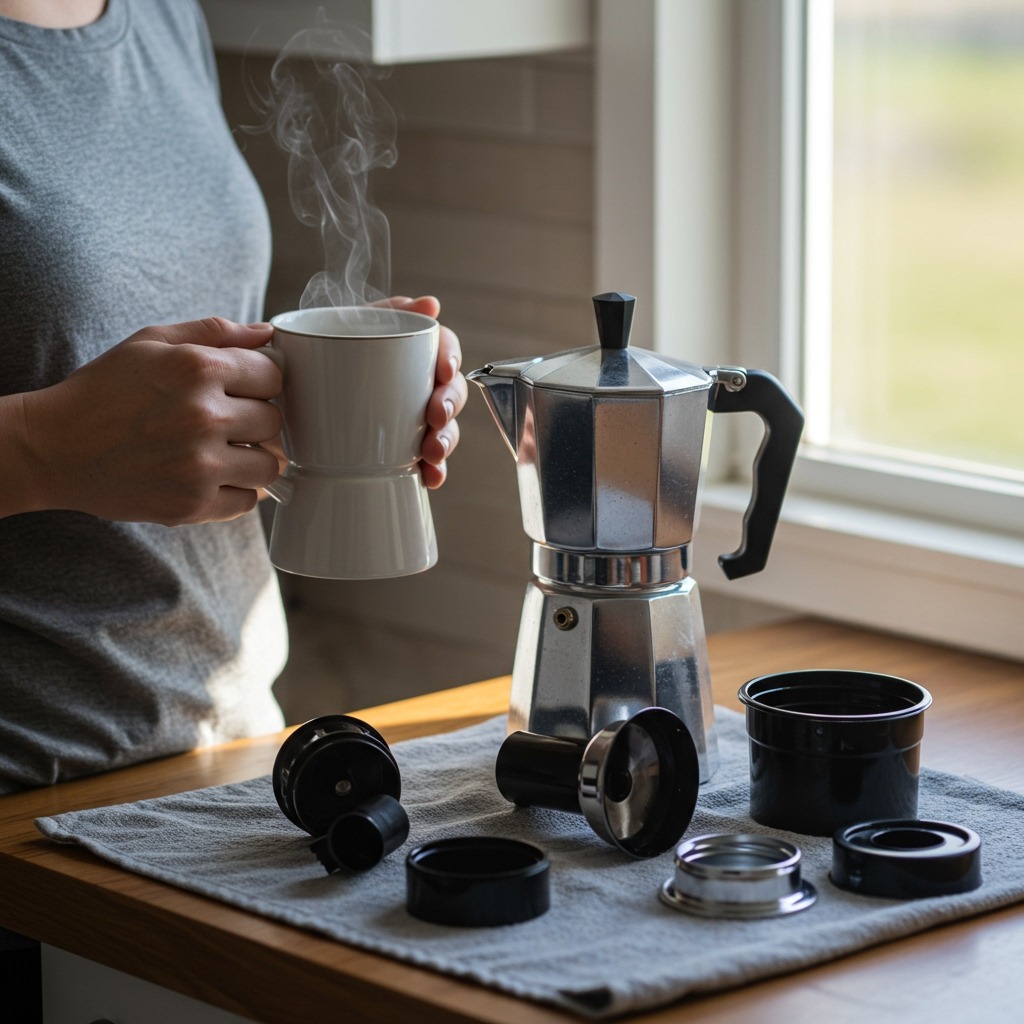Is your trusty coffee maker starting to show signs of… well, trust? Maybe your coffee tastes a little off, a bit bitter. Or perhaps you’ve noticed some chalky white buildup inside the water reservoir. Before you even think about buying a new machine, I’ve got good news. You likely already have the secret weapon to restore its former glory: plain old white vinegar. Learning how to clean a coffee pot with vinegar is a simple, cheap, and incredibly effective way to get your machine sparkling and your coffee tasting great again.
Think about it: your coffee maker works hard, day in and day out. Hot water constantly flows through its internal parts. Over time, this leads to a buildup of mineral deposits (limescale) from your water and coffee oil residues. This gunk not only affects your coffee’s flavor but can also slow down your machine’s brewing process and eventually clog it.
But don’t worry. This guide will walk you through every step of how to clean a coffee pot with vinegar, ensuring you banish that buildup and get back to brewing a perfect cup.
Why Vinegar is Your Coffee Pot’s Best Friend
You might be wondering, “Why vinegar? Are there other options?” While there are commercial descalers, white distilled vinegar is a fantastic choice for several reasons:
- It’s Effective: Acetic acid, the active component in vinegar, is excellent at breaking down mineral deposits (calcium and magnesium) and some coffee oils.
- It’s Cheap: A large bottle of white vinegar costs very little and can be used for numerous cleaning tasks around your home.
- It’s Readily Available: You probably have some in your pantry right now.
- It’s Natural (Mostly): While it’s a product of fermentation, it’s a less harsh alternative to some chemical cleaners.
- It Disinfects: Vinegar has mild disinfectant properties, which can help kill some of the germs and mold that might be lurking in the moist environment of your coffee maker.
So, when it comes to understanding how to clean a coffee pot with vinegar, know that you’re using a time-tested, powerhouse cleaner.
Signs Your Coffee Pot is Crying Out for a Vinegar Cleanse
Not sure if your machine needs descaling? Here are some tell-tale signs:
- Slower Brew Time: If your coffee maker is taking longer than usual to brew a pot, mineral buildup in the heating element and water channels is a likely culprit.
- Coffee Isn’t Hot Enough: Limescale can insulate the heating element, preventing it from heating the water to the optimal temperature.
- Weird Tasting Coffee: A buildup of old coffee oils and mineral deposits can impart a bitter or stale taste to your brew. If you’re asking how to clean a coffee pot with vinegar because your coffee tastes “off,” this is a prime reason.
- Chalky White Residue: You might see this inside the water reservoir or even on the carafe. That’s limescale.
- Your Machine Makes Gurgling or Sputtering Sounds: More than usual, that is. This can indicate a partial blockage.
- Visible Grime or Mold: If you can see gunk or, even worse, mold spots in the reservoir or carafe, it’s definitely past time for a deep clean.
If you notice any of these, it’s time to grab the vinegar.
How to Clean a Coffee Pot with Vinegar: The Step-by-Step Guide
Ready to get started? Here’s your comprehensive guide on how to clean a coffee pot with vinegar. This method works for most standard drip coffee makers.
What You’ll Need:
- White distilled vinegar
- Fresh, cold water
- Your coffee maker (of course!)
- A clean cloth or sponge
- Dish soap (for cleaning removable parts)
The Cleaning Process:
- Empty and Prep Your Coffee Pot:
- Make sure there are no old coffee grounds in the filter basket. Discard them.
- Empty any remaining coffee from the carafe. Give the carafe and filter basket a quick rinse with hot water.
- Create the Vinegar Solution:
- You’ll want a solution of equal parts white distilled vinegar and water. For a standard 10-12 cup coffee maker, this usually means about 4-6 cups of vinegar and 4-6 cups of water.
- Pour the vinegar directly into the coffee maker’s water reservoir first, then add the water. Some people prefer to mix it in the carafe first and then pour it into the reservoir – either way works. The key is the ratio.
- Why this ratio? Pure vinegar can be a bit harsh for some machines, and diluting it helps protect the internal components while still being effective enough to break down buildup.
- Place the Carafe and a Clean Filter (Optional but Recommended):
- Put the empty carafe onto the warming plate.
- You can place a clean paper filter into the filter basket. This isn’t strictly necessary for the descaling process itself, but it can help catch any larger pieces of dislodged mineral deposits or debris, making the final cleanup a bit easier.
- Run a Half Brew Cycle:
- Turn on your coffee maker and let it run as if you were brewing a pot of coffee.
- Allow the machine to brew about half of the vinegar-water solution into the carafe.
- Once it’s about halfway through, turn off the coffee maker.
- Let It Soak – The Magic Happens Here:
- Now, let the coffee maker sit with the remaining vinegar solution in the reservoir and the brewed portion in the carafe for about 30 minutes to 1 hour.
- This “soak time” is crucial. It allows the warm vinegar solution to work its magic, dissolving the limescale and coffee oil buildup within the internal workings of your machine. Don’t rush this step!
- Complete the Brew Cycle:
- After the soak, turn the coffee maker back on and let it finish brewing the rest of the vinegar-water solution into the carafe.
- Discard the Vinegar Solution and Inspect:
- Once the brew cycle is complete and the machine has cooled slightly, carefully pour the hot vinegar-water solution from the carafe down the sink.
- Look at the solution. You might be surprised (and slightly horrified) by the gunk and particles it contains! This is a good sign – it means the vinegar did its job.
- The All-Important Rinsing Cycles (Don’t Skip This!):
- This is perhaps the most critical part of learning how to clean a coffee pot with vinegar properly. You must thoroughly rinse the machine to remove all traces of vinegar. If you don’t, your next few pots of coffee will have a distinctly vinegary tang.
- Fill the water reservoir with fresh, cold water.
- Run a full brew cycle with just the plain water, letting it brew into the carafe. Discard the water.
- Repeat this plain water rinse cycle at least two more times. So, a minimum of three full rinse cycles. Some sources even recommend 4-5 rinse cycles, especially if you are sensitive to the smell or taste of vinegar.
- After the final rinse, smell the inside of the reservoir and the carafe. If you still detect a strong vinegar odor, run another plain water cycle.
- Clean the Removable Parts:
- While the rinse cycles are running, take the time to clean the carafe, filter basket, and any other removable parts.
- Wash them thoroughly in your sink with hot, soapy water. Use a soft sponge or cloth to scrub away any coffee stains or oily residue.
- Rinse these parts well. Many are also top-rack dishwasher safe, but check your coffee maker’s manual to be sure. Using products like Dawn Dish Soap can be effective for cutting through coffee oils.
- Wipe Down the Exterior:
- Use a damp cloth (you can add a drop of dish soap if needed, or use a bit of the diluted vinegar solution for stubborn spots) to wipe down the outside of your coffee maker, including the warming plate.
- Dry it with a clean towel.
- Reassemble and Admire:
- Once everything is clean and dry, reassemble your coffee maker.
- Step back and admire your sparkling clean machine! You’re now ready to brew a delicious, fresh-tasting pot of coffee.
How Often Should You Clean Your Coffee Pot with Vinegar?
The ideal frequency for descaling your coffee maker with vinegar depends on a couple of factors:
- Your Water Hardness: If you have hard water (water with a high mineral content), you’ll need to descale more frequently, perhaps as often as once a month. If you have soft water, you might get away with doing it every 2-3 months or even less. Unsure about your water? Your local municipality can often provide information on water hardness.
- How Often You Use It: If you brew multiple pots a day, you’ll need to clean it more often than someone who only brews a few times a week.
General Guideline: Aim to descale your coffee maker using the vinegar method every 1 to 3 months. Set a reminder on your phone or calendar. Regular cleaning is key to preventing heavy buildup and keeping your coffee tasting its best.
Important Considerations and What to Avoid
While learning how to clean a coffee pot with vinegar is straightforward, keep these points in mind:
- Always Use White Distilled Vinegar: Avoid apple cider vinegar or other types of vinegar. They can leave behind their own residues or flavors and may not be as effective for descaling.
- Check Your Manufacturer’s Instructions: Some coffee maker manufacturers might advise against using vinegar, or they may recommend a specific descaling solution, especially for high-end or espresso machines with delicate components. Always consult your owner’s manual first. If it explicitly says not to use vinegar, follow that advice to avoid voiding your warranty.
- Don’t Use Undiluted Vinegar (Usually): While some people advocate for using full-strength vinegar for very heavy buildup, it’s generally safer to start with a 1:1 diluted solution. Pure vinegar is more acidic and could potentially be too harsh on certain plastic or rubber components over time if used repeatedly.
- Never Mix Vinegar with Bleach: This is a crucial safety warning for all cleaning, not just coffee pots. Mixing vinegar (an acid) with bleach (a chlorine product) creates toxic chlorine gas, which is extremely dangerous.
- Ventilation: While not overly noxious, vinegar does have a strong smell. You might want to open a window or turn on your kitchen vent fan while you’re running the vinegar solution through your machine.
- Be Careful with Hot Liquids: The brewed vinegar solution and the rinse water will be very hot. Handle the carafe with care to avoid burns.
What About Cleaning Other Types of Coffee Makers with Vinegar?
- Keurig or Single-Serve Pod Machines: Yes, you can often descale Keurig machines with vinegar using a similar process (running vinegar solution through the reservoir). However, Keurig also sells its own descaling solution, and it’s crucial to check your specific model’s manual for instructions, as the process might be slightly different (e.g., specific button combinations for a descale mode).
- Espresso Machines: This is where you need to be more cautious. Many espresso machines have more complex internal parts, including aluminum boilers, which can be damaged by the acidity of vinegar. Always refer to your espresso machine’s manual. Often, manufacturers will recommend specific descaling products (usually citric acid-based) formulated for espresso machines. Using vinegar could void the warranty.
- Percolators or Moka Pots: Vinegar can be used to clean these, but you’ll mainly be soaking the components and then scrubbing and rinsing thoroughly.
The core principle of how to clean a coffee pot with vinegar – using its acidic properties to dissolve buildup – applies broadly, but always prioritize your manufacturer’s specific care instructions.
Beyond Vinegar: Other Cleaning Tips for Your Coffee Station
While descaling with vinegar is vital, here are a few more tips to keep your entire coffee setup in top shape:
- Clean the Carafe Daily: Don’t just rinse it. Wash it with soap and water after each use to prevent coffee oils from building up and turning rancid, which affects flavor.
- Wash the Filter Basket Regularly: This also accumulates oils and fine coffee particles.
- Wipe Spills Immediately: Coffee spills can stain surfaces and attract pests.
- Clean Your Coffee Grinder: Coffee bean oils also build up in your grinder, affecting the flavor of your freshly ground beans. Use grinder cleaning tablets or grind some uncooked white rice through it (then discard) to clean it out.
A clean coffee maker and a clean coffee station lead to a consistently better coffee experience. Knowing how to clean a coffee pot with vinegar is a cornerstone of that.
Read more: How to Clean a Coffee Pot: The Complete, No-Nonsense Guide
Frequently Asked Questions (FAQ) – How to Clean a Coffee Pot with Vinegar
Q1: How much vinegar do I use to clean a coffee pot?
A: Use a solution of equal parts white distilled vinegar and water. For a typical 10-12 cup coffee maker, this usually means 4-6 cups of vinegar mixed with 4-6 cups of water, filled to the reservoir’s maximum line.
Q2: Is it safe to run vinegar through a coffee maker?
A: Yes, for most standard drip coffee makers, it is safe to run a diluted white distilled vinegar solution through the machine for descaling. However, always check your coffee maker’s manual first, as some manufacturers may recommend specific descaling solutions or advise against vinegar, especially for espresso machines or those with aluminum components.
Q3: How many times should I rinse my coffee maker after cleaning with vinegar?
A: You should run at least three full brew cycles with fresh, plain water after the vinegar cycle to thoroughly rinse away any vinegar residue and prevent a vinegary taste in your coffee. Some prefer 4-5 rinses.
Q4: Can I use apple cider vinegar to clean my coffee pot?
A: It’s best to use white distilled vinegar. Apple cider vinegar has a different composition, may contain sugars or other impurities that could leave residue, and isn’t as effective for descaling.
Q5: What happens if I don’t clean my coffee pot?
A: Mineral deposits (limescale) from water and coffee oil residues will build up. This can make your coffee taste bitter or off, slow down the brewing process, prevent the water from getting hot enough, and eventually clog your machine. Mold and bacteria can also grow in a dirty coffee maker.
Q6: How often should I clean my coffee machine with vinegar?
A: A general guideline is every 1 to 3 months. If you have very hard water or use your coffee maker heavily, you may need to do it monthly. If you have soft water, you might do it less frequently.
Q7: Can I leave the vinegar solution in the coffee maker overnight?
A: While a soak time of 30 minutes to an hour is usually sufficient, some people do leave it longer for very heavy buildup. However, prolonged exposure to concentrated acid isn’t always better and could potentially stress older or more delicate components. Sticking to the 1-hour soak is a good general practice. For extremely stubborn buildup, you might repeat the entire cleaning process rather than doing an excessively long soak.
By following these steps on how to clean a coffee pot with vinegar, you’re not just cleaning; you’re investing in better-tasting coffee and a longer life for your machine. Happy brewing!




